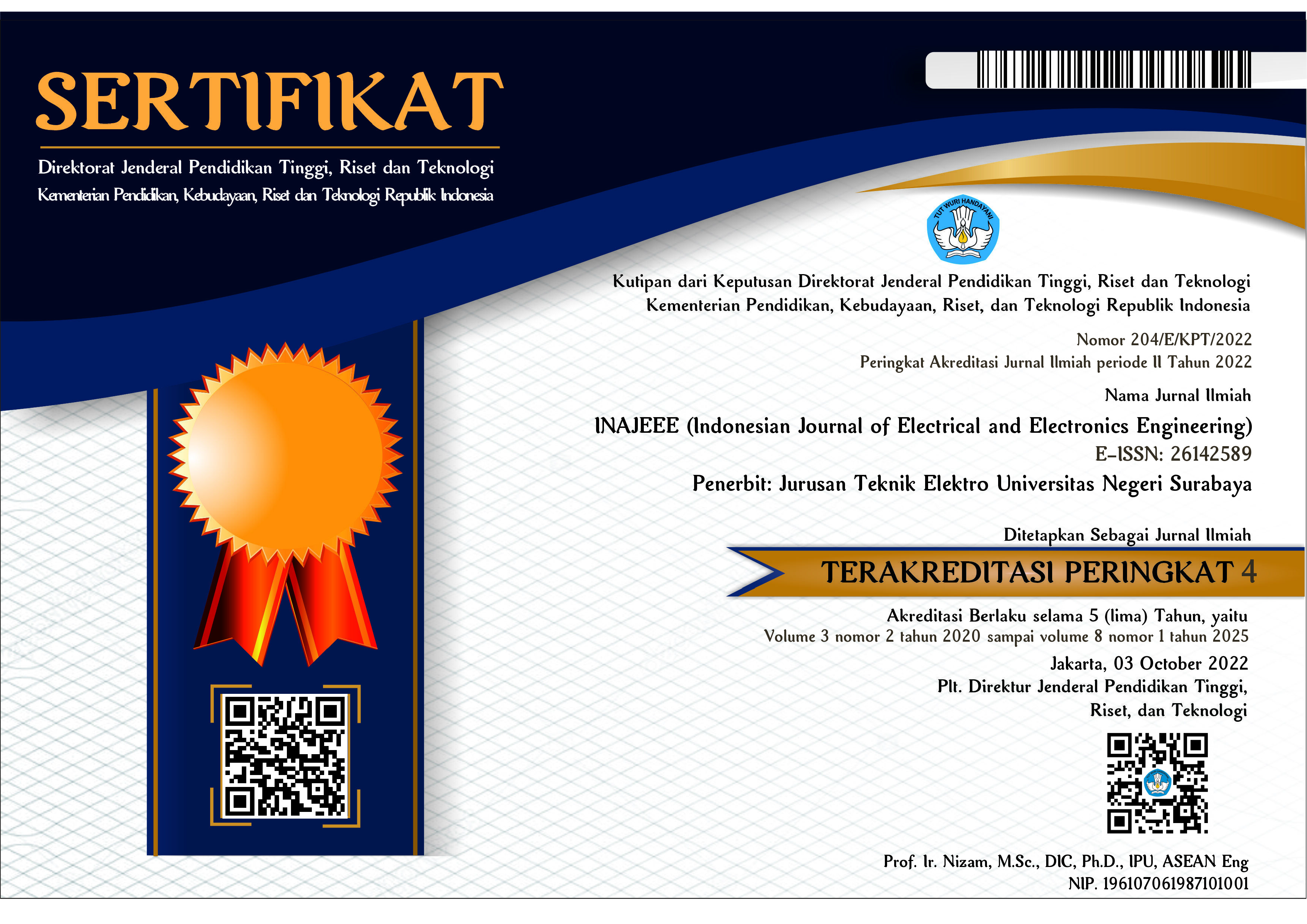Optimasi Linieritas Rangkaian R-2R Ladder DAC Menggunakan Algoritma Genetika
DOI:
https://doi.org/10.26740/inajeee.v1n1.p7-11Keywords:
genetic algorithm, R-2R ladder, digital-to-analog converter, integral non-linearityAbstract
Abstrak - rangkaian R-2R ladder digital-to-analog converter (DAC) adalah rangkaian elektronika sederhanayang dapat dibuat dengan dua nilai resistor serta banyak digunakan untuk proses konversi nilai digital ke
analog secara langsung. Pemilihan nilai serta penempatan resistor pada rangkaian ini sangat berpengaruh
pada linieritas sinyal hasil konversi. Penelitian ini bertujuan untuk memberikan solusi dalam merancang
rangkaian R-2R ladder DAC dengan linieritas yang medekati optimal menggunakan komponen resistor yang
ada di pasaran. Dengan bantuan algoritma genetika, komponen resistor yang ada dapat dirangkai sedemikian
rupa sehingga menghasilkan rangkaian DAC dengan nilai integral non-linearity (INL) yang mendekati
optimal. Hasil yang didapatkan dari simulasi rangkaian DAC dengan jumlah bit 6 sampai 12 menunjukkan
bahwa algoritma genetika dapat digunakan untuk mengoptimalkan linieritas rangkaian R-2R ladder DAC
dengan INL hingga di bawah 0.5 LSB dalam waktu kurang dari 1.5 menit.
Kata Kunci: algoritma genetika, R-2R ladder, digital-to-analog converter, integral non-linearity
Abstract - R-2R ladder digital-to-analog converter (DAC) is a simple electronic circuit that can be
implemented with only two resistor values. It is used for converting digital values to analog voltage
directly. The resistor selection and placement in this circuit have a significant effect on the DAC
linearity. This research aims to provide solution in designing R-2R ladder DAC circuit with close-tooptimum
linearity using only resistors available on the market. With the help of genetic algorithm, the
existing resistors can be sequenced in such a way to produce a DAC circuit with close-to-optimum
integral non-linearity (INL). The results obtained from the simulation using 6 to 12 bits DAC circuits
show that the genetic algorithm can be used to optimize the linearity of R-2R ladder DAC with INL
less than 0.5 LSB in less than 1.5 minutes.
Keywords: genetic algorithm, R-2R ladder, digital-to-analog converter, integral non-linearity
References
Akbari I. Basuki dan Oka Mahendra, œPurwarupa modem audio
berbasis mikrokontroler dengan teknik direct digital synthesizer dan
zero crossing detector, INKOM, vol. 7, no. 2, article 252, Nov. 2013.
[2] A. Rahmawati, S. Winardi, D. Tristianto, œRancang bangun alat
pengukur suhu tubuh dengan tampilan digital dan keluaran suara
berbasis mikrokontroller AVR AT Mega 8535, Jurnal Monitor, vol. 1,
no. 1, Juli 2012.
[3] B. Fatkhurrozi, I. Nawawi, Sudaryanto, œRancang bangun audio
generator untuk frekuensi 20 Hz 10 kHz berbasis mikrokontroler
AT89S52, Jurnal Penelitian Inovasi, vol. 32, no. 2, Aug. 2009.
[4] L. Hakim, œRancang bangun sistem pengaturan penerangan ruangan
berbasis mikrokontroler, Jurusan Teknik Elektro, Politeknik
Elektronika Negeri Surabaya, 2011.
[5] M. P. Kennedy, œOn the robustness of R-2R ladder DACs, IEEE
Trans. on Circuits and System-Part I, vol. 47, no. 2, Feb. 2000.
[6] Y. Lin, D. J. Chen, and R. Geiger, œYield enhancement with optimal
area allocation for ratio critical analog circuits, IEEE Trans. Circuits
Syst. I, Reg. Papers, vol. 53, pp. 534-553, Mar. 2006.
[7] B. Abraham, œThe optimization and implementation of weight-based
device area allocation for ratio-critical analog integrated circuit, M.Sc.
thesis, National Taiwan University of Science and Technology, Taipei,
Taiwan, Jan. 2016.
[8] E. Martiana dan Y. Setiowati, Bab 7 Algoritma Genetika, ser. Lecture
Notes in Kecerdasan Buatan, Politeknik Elektronika Negeri Surabaya,
2011.
[9] Joshep Kirk. (2014) Traveling Salesman Problem - Genetic Algorithm
[Online],
https://www.mathworks.com/matlabcentral/fileexchange/13680-
traveling-salesman-problem-genetic-algorithm, tanggal akses: 10 Mei
berbasis mikrokontroler dengan teknik direct digital synthesizer dan
zero crossing detector, INKOM, vol. 7, no. 2, article 252, Nov. 2013.
[2] A. Rahmawati, S. Winardi, D. Tristianto, œRancang bangun alat
pengukur suhu tubuh dengan tampilan digital dan keluaran suara
berbasis mikrokontroller AVR AT Mega 8535, Jurnal Monitor, vol. 1,
no. 1, Juli 2012.
[3] B. Fatkhurrozi, I. Nawawi, Sudaryanto, œRancang bangun audio
generator untuk frekuensi 20 Hz 10 kHz berbasis mikrokontroler
AT89S52, Jurnal Penelitian Inovasi, vol. 32, no. 2, Aug. 2009.
[4] L. Hakim, œRancang bangun sistem pengaturan penerangan ruangan
berbasis mikrokontroler, Jurusan Teknik Elektro, Politeknik
Elektronika Negeri Surabaya, 2011.
[5] M. P. Kennedy, œOn the robustness of R-2R ladder DACs, IEEE
Trans. on Circuits and System-Part I, vol. 47, no. 2, Feb. 2000.
[6] Y. Lin, D. J. Chen, and R. Geiger, œYield enhancement with optimal
area allocation for ratio critical analog circuits, IEEE Trans. Circuits
Syst. I, Reg. Papers, vol. 53, pp. 534-553, Mar. 2006.
[7] B. Abraham, œThe optimization and implementation of weight-based
device area allocation for ratio-critical analog integrated circuit, M.Sc.
thesis, National Taiwan University of Science and Technology, Taipei,
Taiwan, Jan. 2016.
[8] E. Martiana dan Y. Setiowati, Bab 7 Algoritma Genetika, ser. Lecture
Notes in Kecerdasan Buatan, Politeknik Elektronika Negeri Surabaya,
2011.
[9] Joshep Kirk. (2014) Traveling Salesman Problem - Genetic Algorithm
[Online],
https://www.mathworks.com/matlabcentral/fileexchange/13680-
traveling-salesman-problem-genetic-algorithm, tanggal akses: 10 Mei
 Abstract views: 1233
,
Abstract views: 1233
, PDF Downloads: 869
PDF Downloads: 869



